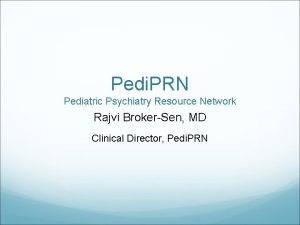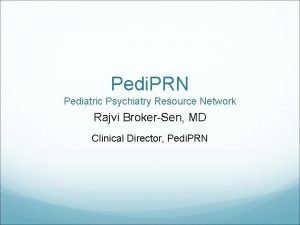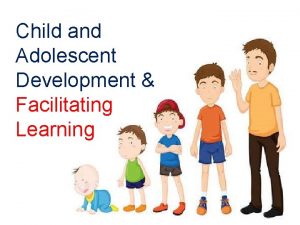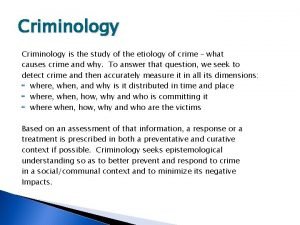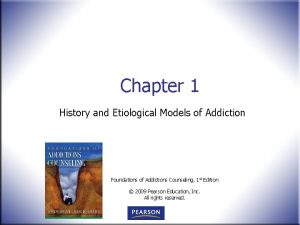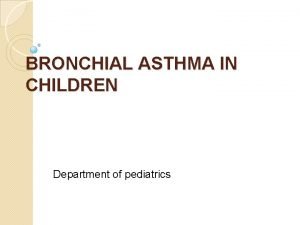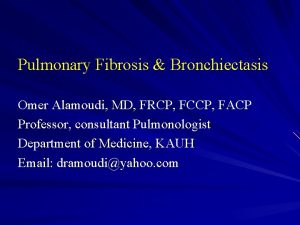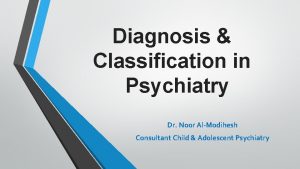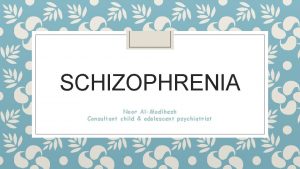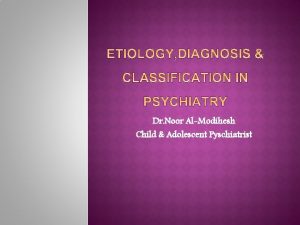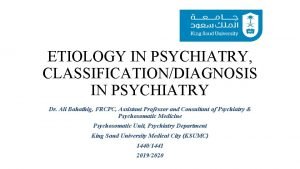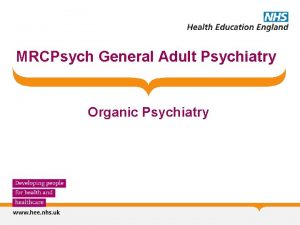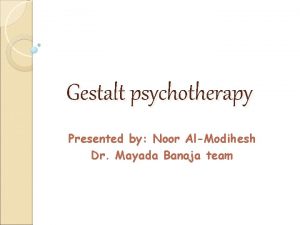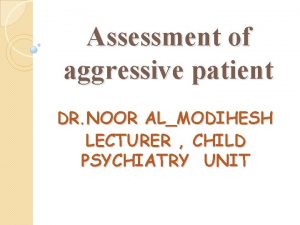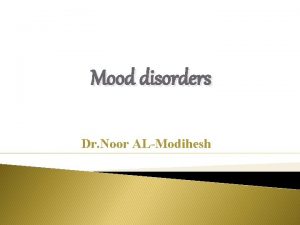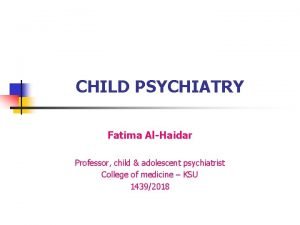Etiology Classification in psychiatry Noor Almodihesh Child Adolescent













- Slides: 13

Etiology & Classification in psychiatry Noor Almodihesh Child & Adolescent Psychiatrist

• Diagnosis introduces order and structure to our thinking and reduces the complexity of clinical phenomena. • Diagnoses help to predict outcome • Diagnoses are often used to choose an appropriate treatment

Significance of Dx & Classification: 1. To distinguish one diagnosis from another. 2. To enable clinicians to communicate with one another about dx, treatment and prognosis. 3. To ensure that psychiatric research can be conducted with comparable groups of patients.

Organic Mental Disorder psychiatric disorders characterized by neurocognitive structural brain pathology that can be detected by clinical assessment or usual tests. E. g. delirium, dementia, substance-induced mental disorders, and medication-induced mental disorders.

Features Suggestive of Organic Mental Disorders (CNS pathology); • Disturbed consciousness +/ • Other cognitive disturbance in: attention, concentration, orientation or memory. • Physical illness (e. g. diabetes, hypertension) • Vital signs disturbances (e. g. fever, high BP). • Neurological features (e. g. ataxia, dysarthria

• Non-organic (functional) Mental Disorders: No obvious structural brain pathology. E. g. Schizophrenia, mood disorders, anxiety disorders, adjustment disorders.

Psychosis vs. Neurosis Classification although this classification is no longer used in the official current systems of classification (DSM & ICD), in everyday clinical practice these terms are still used widely; hence it is of practical value to know this distinction.

DSM-5 Classification (May 2013) • an evidence-based manual useful in accurately and consistently diagnose mental disorders • DSM-5 represents the contributions of more than 700 distinguished mental health and medical experts during an extensive and rigorous 14 -year development process

Neurocognitive Disorders • • • Delirium Mild Neurocognitive Disorders Major Neurocognitive Disorders Schizophrenia Spectrum and Other Psychotic Disorders • • Schizophrenia Brief Psychotic Disorder Schizophreniform Disorder Schizoaffective Disorder Delusional Disorder Substance/Medication-Induced Psychotic Disorder Due to Another Medical Condition Catatonia Bipolar and Related Disorders • • • Bipolar I & II Disorders Cyclothymic Disorder Substance/Medication-Induced Bipolar and Related Disorder Due to Another Medical Condition

Etiology in Psychiatry • The Complexity of etiology in Psychiatry • 1. Time factor: causes are often remote in time from the effect they produce. • 2. Single cause may lead to several psychological effects e. g. deprivation from parental affection may lead to depression or conduct disorder in children and adolescents. • 3. Single effect may arise from several causes e. g. depression may be due to accumulation of several causes like endocrinopathies, psychosocial stresses and side effects of some drugs. Most psychiatric disorders are multifactorial.

Main causative factors in psychiatry • A. Genetic : e. g. in schizophrenia , mood disorders , panic disorder and • • • agoraphobia. B. Neuropathological: e. g. dementias , delirium. C. Endocrinopathological: e. g. hyperthyroidism / hypothyroidism. D. Pharmacological: side effects of medications e. g. steroids > mood changes. E. Social: e. g. marital discord /occupational problems/financial difficulties. F. Psychological : behavioral , cognitive , or psychodynamic problems (subconscious processes that involve distortion of reality in order to deal with, and resolve the intra-psychic conflict (defense mechanism).

Supernatural causal attributions; although many cultures view black magic (sorcery), evil eye, and devil possession hidden causes of mental diseases it is impossible to subjects such supernatural matters to empirical research. ﺍﻟﻌﻴﻦ ؟ ﺍﻟﺴﺤﺮ ؟ ﺍﻟﺤﺴﺪ ؟

Source : • Psychiatry Text Book , Prof. al-Sughayir
 National network of child psychiatry access programs
National network of child psychiatry access programs National network of child psychiatry access programs
National network of child psychiatry access programs Facilitating learning child and adolescent development
Facilitating learning child and adolescent development Infants, children and adolescents 8th edition
Infants, children and adolescents 8th edition Criminology etiology
Criminology etiology Multicausal model of addiction
Multicausal model of addiction Types of bronchial asthma
Types of bronchial asthma Pathology of asthma
Pathology of asthma Pathophysiology of appendicitis
Pathophysiology of appendicitis Definition of rampant caries
Definition of rampant caries Writing pes statements
Writing pes statements Etiology
Etiology Synonyms for etiology
Synonyms for etiology Etiology
Etiology
